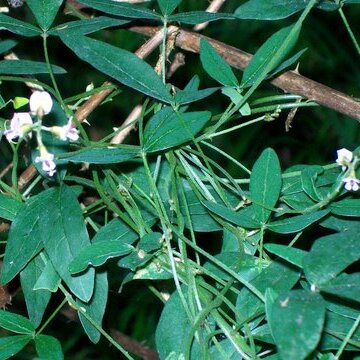Herbs perennial. Stems slender, procumbent, usually curved, many branched at base, nodes obvious, sparsely pubescent. Leaves pinnately 3-foliolate; stipules lanceolate, ca. 2 mm, villous; petiole 2-3 cm, sparsely strigose; stipels linear, ca. 1 mm, hairy; leaflets at lower part of stem obovate or ovate to oblong, 0.7-1.2 × 0.4-0.8 cm, both surfaces adpressed white villous, denser abaxially, lateral veins 5-7 pairs, curved, reticulate veins visible, base rounded, apex obtusely rounded, truncate or slightly emarginate, mucronate; leaflets at upper part of stem ovate-lanceolate, narrowly elliptic-oblong, or linear, 1.2-3.2 cm × 5-8 mm. Raceme slender and spreading, 1-5.5 cm; peduncle 3-7.5 cm; bracts linear, villous; flowers sparse, usually 1 per bract or 2 or 3 clustered at lower part of rachis. Flowers 7-9 mm; pedicel ca. 2 mm; bracteoles slender. Calyx membranous, campanulate, densely strigose; lobes 5, triangular, longer than tube, upper 2 connate to middle. Corolla purple or light purple; standard orbicular, ca. 15 mm in diam., with claw; wings and keels smaller, with auricles and claws. Ovary with short stipe, many ovuled. Legume oblong, straight, not constricted between seeds, 20-25 × ca. 2 mm, adpressed white villous, stipe short, apex with beak ca. 2 mm. Seeds 2-5, dark brown, cylindric, truncate at 2 ends, ca. 2.5 × 2 mm; testa not shiny, with granular small nodules. Fl. Mar-Jul, fr. May-Oct. 2n = 40, 80.
More
A creeping herb which keeps growing from year to year. It can trail along the ground or be a climber. The stems are slender. The rootstock is woody. The leaves have 3 leaflets. The leaflets are 5 cm long by 0.7 cm wide. The end leaflet is the largest. The flowers are pea shaped. They are 0.7 cm across and blue or purple. They occur in groups on stalks 4-20 cm long in the axils of leaves. The fruit are pods 3 cm long by 0.4 cm wide. They are slightly hairy.

